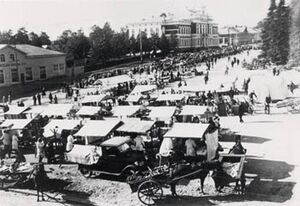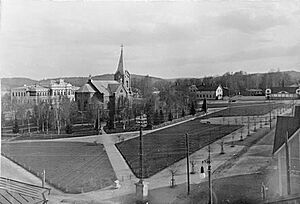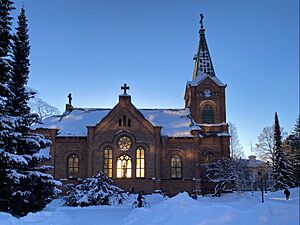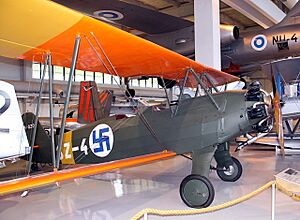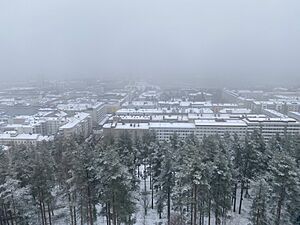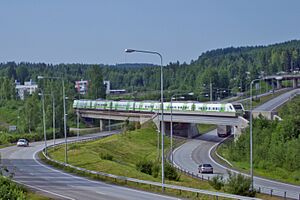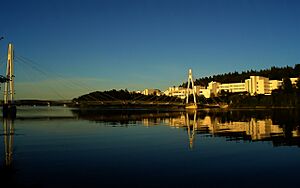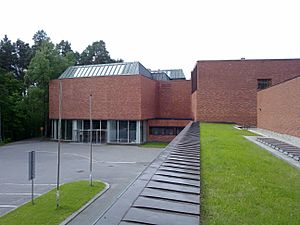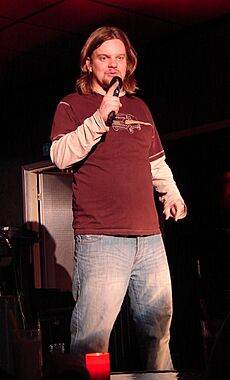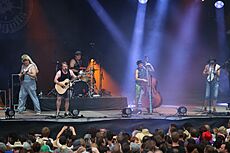Jyväskylä facts for kids
Quick facts for kids
Jyväskylä
|
||
|---|---|---|
|
City
|
||
| Jyväskylän kaupunki Jyväskylä stad City of Jyväskylä | ||
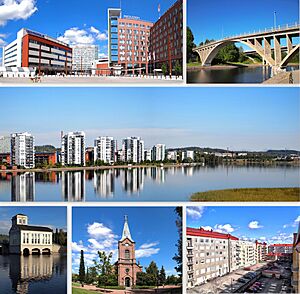
Clockwise from top-left: Lutakko Square, Äijälänsalmi Strait, apartments in Lutakko, old power station of Vaajakoski, the Jyväskylä City Church, and a courtyard in downtown Jyväskylä
|
||
|
||
| Nickname(s): | ||
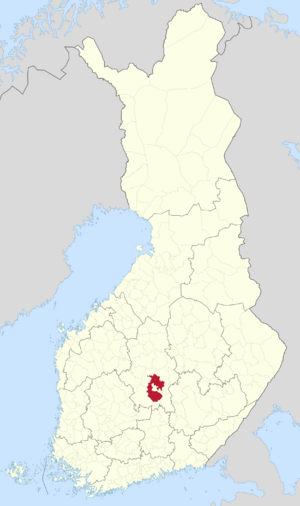
Location of Jyväskylä in Finland
|
||
| Country | ||
| Region | Central Finland | |
| Sub-region | Jyväskylä sub-region | |
| Charter | 1837 | |
| Area
(2018-01-01)
|
||
| • City | 1,466.35 km2 (566.16 sq mi) | |
| • Land | 1,171.03 km2 (452.14 sq mi) | |
| • Water | 295.35 km2 (114.04 sq mi) | |
| • Urban | 99.25 km2 (38.32 sq mi) | |
| Area rank | 61st largest in Finland | |
| Population
(2023-12-31)
|
||
| • City | 147,746 | |
| • Rank | 7th largest in Finland | |
| • Density | 126.17/km2 (326.8/sq mi) | |
| • Urban | 117,974 | |
| • Urban density | 1,188.7/km2 (3,079/sq mi) | |
| Population by native language | ||
| • Finnish | 93% (official) | |
| • Swedish | 0.2% | |
| • Others | 6.8% | |
| Population by age | ||
| • 0 to 14 | 15.2% | |
| • 15 to 64 | 66.2% | |
| • 65 or older | 18.6% | |
| Time zone | UTC+02:00 (EET) | |
| • Summer (DST) | UTC+03:00 (EEST) | |
| Unemployment rate | 11.8% | |
Jyväskylä is a lively city in Finland. It is the main city of the Central Finland region. Jyväskylä is located in the beautiful Finnish Lakeland, a region with many lakes.
About 147,000 people live in Jyväskylä. This makes it the 7th most populated city in Finland. The larger Jyväskylä area has even more people.
Jyväskylä is sometimes called the "Athens of Finland." This is because it's a big center for education. It's also known as the "capital of Finnish rap" and the "capital of Finnish sport." The famous architect Alvar Aalto designed many buildings here. The city also hosts the exciting Rally Finland car race.
Contents
What's in a Name?
The name Jyväskylä has two parts. Kylä means "village." The first part, jyväs-, might come from the word jyvä, which means "grain."
Some people think the name could be linked to a type of tree called a yew. Another idea is that jyväs refers to the sun's light reflecting off the water.
A museum curator, Erkki Fredrikson, thought the original word might have been syväs, meaning "deep." He believed the name came from a "deep river" instead of a "grain river."
A Look Back in Time
People have lived in the Jyväskylä area since the Stone Age. The city of Jyväskylä was officially founded on March 22, 1837. This happened when Nicholas I of Russia, who was also the Grand Duke of Finland, signed the city's charter. Before this, Jyväskylä was just a village in a larger rural area.
A very important step for Jyväskylä was the opening of schools in the 1850s and 1860s. The first three schools in the world that taught in Finnish were started here. These included a high school in 1858, a teachers’ college in 1863, and a girls’ school in 1864. These schools brought many teachers and students to the city, changing its atmosphere.
In the 20th century, Jyväskylä grew very quickly. After World War II, many people moved to the city, and new homes were needed. In the 21st century, the city continues to grow fast, with over 1,000 new residents each year.
City Geography
Jyväskylä is located on the northern shore of Päijänne, Finland's second-largest lake. It's about 147 kilometers northeast of Tampere and 270 kilometers north of Helsinki. The area around Jyväskylä is very hilly and forested, with many lakes.
Jyväskylä is a big part of the Finnish Lakeland. There are 328 lakes within the city limits! Lakes and rivers make up about 20% of the city's total area. The main city center sits on the shores of a smaller lake called Jyväsjärvi. The famous architect Alvar Aalto once compared Jyväskylä's hilly landscape to Toscana in Italy.
Weather and Climate
Jyväskylä has a subarctic continental climate. This means winters are long, snowy, cold, and dark. In the middle of winter, the city only gets about five hours of daylight. Summers are mild, with average daily high temperatures around 22°C in July. During summer, Jyväskylä enjoys long daylight hours and "white nights," where it never gets completely dark.
| Climate data for Jyväskylä Airport (1991-2020 normals, extremes 1959-present) | |||||||||||||
|---|---|---|---|---|---|---|---|---|---|---|---|---|---|
| Month | Jan | Feb | Mar | Apr | May | Jun | Jul | Aug | Sep | Oct | Nov | Dec | Year |
| Record high °C (°F) | 7.8 (46.0) |
11.0 (51.8) |
16.2 (61.2) |
22.6 (72.7) |
29.3 (84.7) |
32.8 (91.0) |
34.2 (93.6) |
32.3 (90.1) |
26.2 (79.2) |
20.1 (68.2) |
13.2 (55.8) |
9.4 (48.9) |
34.2 (93.6) |
| Mean maximum °C (°F) | 3.3 (37.9) |
3.4 (38.1) |
8.6 (47.5) |
16.8 (62.2) |
24.3 (75.7) |
26.8 (80.2) |
28.1 (82.6) |
26.3 (79.3) |
20.4 (68.7) |
13.0 (55.4) |
7.6 (45.7) |
3.9 (39.0) |
29.3 (84.7) |
| Mean daily maximum °C (°F) | −4.3 (24.3) |
−3.9 (25.0) |
0.9 (33.6) |
7.5 (45.5) |
15.0 (59.0) |
19.4 (66.9) |
22.0 (71.6) |
19.8 (67.6) |
13.9 (57.0) |
6.4 (43.5) |
1.2 (34.2) |
−2.1 (28.2) |
8.0 (46.4) |
| Daily mean °C (°F) | −7.3 (18.9) |
−7.6 (18.3) |
−3.5 (25.7) |
2.5 (36.5) |
9.1 (48.4) |
14.0 (57.2) |
16.7 (62.1) |
14.6 (58.3) |
9.4 (48.9) |
3.6 (38.5) |
−0.9 (30.4) |
−4.5 (23.9) |
3.8 (38.9) |
| Mean daily minimum °C (°F) | −10.9 (12.4) |
−11.5 (11.3) |
−8.1 (17.4) |
−2.4 (27.7) |
2.8 (37.0) |
8.2 (46.8) |
11.2 (52.2) |
9.5 (49.1) |
5.1 (41.2) |
0.6 (33.1) |
−3.2 (26.2) |
−7.5 (18.5) |
−0.5 (31.1) |
| Mean minimum °C (°F) | −26.4 (−15.5) |
−26.4 (−15.5) |
−20.3 (−4.5) |
−11.2 (11.8) |
−4.5 (23.9) |
0.8 (33.4) |
4.7 (40.5) |
2.4 (36.3) |
−2.6 (27.3) |
−8.8 (16.2) |
−14.4 (6.1) |
−20.7 (−5.3) |
−29.9 (−21.8) |
| Record low °C (°F) | −38.5 (−37.3) |
−38.5 (−37.3) |
−32.7 (−26.9) |
−20.5 (−4.9) |
−9.0 (15.8) |
−3.3 (26.1) |
0.9 (33.6) |
−2.2 (28.0) |
−9.2 (15.4) |
−19.3 (−2.7) |
−27.2 (−17.0) |
−34.8 (−30.6) |
−38.5 (−37.3) |
| Average precipitation mm (inches) | 43 (1.7) |
33 (1.3) |
32 (1.3) |
33 (1.3) |
43 (1.7) |
67 (2.6) |
79 (3.1) |
67 (2.6) |
58 (2.3) |
65 (2.6) |
53 (2.1) |
50 (2.0) |
622 (24.5) |
| Average precipitation days (≥ 0.1 mm) | 22 | 18 | 15 | 12 | 13 | 15 | 16 | 15 | 16 | 19 | 21 | 22 | 204 |
| Average snowy days | 28.5 | 27.2 | 28.9 | 19.1 | 0.0 | 0.0 | 0.0 | 0.0 | 0.1 | 6.1 | 19.4 | 26.2 | 155.5 |
| Mean monthly sunshine hours | 25 | 63 | 136 | 179 | 252 | 244 | 261 | 208 | 123 | 59 | 20 | 10 | 1,580 |
| Source 1: FMI climatological normals for Finland 1991-2020 Weatheronline.co.uk | |||||||||||||
| Source 2: record highs and lows | |||||||||||||
People of Jyväskylä
Population Growth
The city of Jyväskylä has about 147,746 people. It is the 7th most populated city in Finland. The wider Jyväskylä region has a population of about 191,187.
Jyväskylä was the fastest-growing city in Finland during the 20th century. It has continued to grow quickly in the 21st century.
| Year | Population |
|---|---|
| 1980 |
96,966
|
| 1985 |
99,993
|
| 1990 |
103,921
|
| 1995 |
109,657
|
| 2000 |
116,519
|
| 2005 |
124,205
|
| 2010 |
130,816
|
| 2015 |
137,368
|
| 2020 |
145,943
|
Languages Spoken
Population by mother tongue (2023) Finnish (93.0%) Russian (1.3%) Farsi (0.5%) English (0.5%) Arabic (0.4%) Kurdish (0.3%) Chinese (0.3%) Other (3.8%)
Most people in Jyväskylä speak Finnish. It is the third largest city in Finland where Finnish is the main language. A small number of people, about 0.2% of the population, speak Swedish.
Because English and Swedish are taught in schools, many people in Jyväskylä can speak more than one language. Over 100 different languages are spoken in the city. The most common foreign languages are Russian, Farsi, English, and Arabic.
People from Other Countries
| Population by country of birth (2022) | ||
| Nationality | Population | % |
|---|---|---|
| 136,897 | 93.8 | |
| 1,133 | 0.8 | |
| 765 | 0.5 | |
| 484 | 0.3 | |
| 420 | 0.3 | |
| 395 | 0.3 | |
| 341 | 0.2 | |
| 301 | 0.2 | |
| 280 | 0.2 | |
| 279 | 0.2 | |
| 238 | 0.2 | |
| Other | 4,354 | 2.9 |
As of 2023, about 10,163 people in Jyväskylä have a background from another country. This is about 6.9% of the population. Most people born outside Finland come from the former Soviet Union, Sweden, Russia, Iran, and Afghanistan.
The number of people from other countries is growing in Jyväskylä. This means the city is becoming more diverse.
Religious Groups
In 2023, the largest religious group in Jyväskylä was the Evangelical Lutheran Church of Finland. About 62.1% of the people belonged to this church. Other religious groups made up 3.1% of the population. A large number of people, 34.8%, did not have a religious affiliation.
City Economy

Jyväskylä has always been a busy place for trade because of its good location. Education has been a key part of the city's economic growth. The first Finnish-speaking schools opened here in the 1850s and 1860s.
Later, industries based on forests, like plywood and paper production, became important. Today, Jyväskylä's main jobs are in education, healthcare, making paper machines, information technology, and renewable energy.
Big private employers include the paper machinery company Metso and the retail company Keskimaa. Major public employers are the City of Jyväskylä, the Central Finland Health Care District, and the University of Jyväskylä.
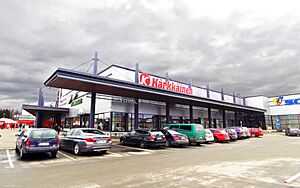
Most jobs in Jyväskylä are in the service sector (78%). Only a small part of the workforce (1%) works in farming or fishing. About 21% work in manufacturing.
In 2011, a study showed that businesses liked Jyväskylä. They praised the city for having skilled workers, good services, and excellent transport links.
Culture and Arts
Jyväskylä is a city rich in culture. It has many museums, theaters, and music events.
Museums to Explore
- The Alvar Aalto Museum shows the important works of the famous architect Alvar Aalto.
- The Museum of Central Finland focuses on the cultural history of the region. Both museums were designed by Alvar Aalto himself.
- The Craft Museum of Finland displays different handicraft techniques from all over the country.
- The Aviation Museum of Central Finland is near the airport and shows Finland's aviation history.
- The University of Jyväskylä Museum tells the story of the university and the nature of Central Finland.
- The Jyväskylä Art Museum is the main art museum for Central Finland.
You can also visit historical churches like the Taulumäki Church and the Jyväskylä City Church.
Theater Fun
The largest theater in the city is the Jyväskylä City Theatre, also designed by Alvar Aalto. It's right in the city center.
There are also many smaller, amateur theater groups that put on shows for all ages. Some popular ones include Huoneteatteri and the Jyväskylä University Student Theatre.
Music Scene
Jyväskylä has become known as a strong center for rap music in Finland. It's even called the "capital of Finnish rap." Many talented rap artists, like Gettomasa, come from here.
Annual Events and Festivals
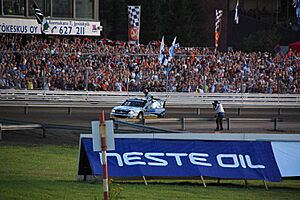
Jyväskylä hosts many exciting events throughout the year:
- Arctic and Fabulous Film Festival (February): Shows Nordic films in winter.
- Jyrock (April): An indie and alternative rock and pop music festival.
- Yläkaupungin Yö (May): One of the city's biggest annual street festivals.
- Sataman Yö (June): A pop music festival held by the harbor.
- Jyväskylä Arts Festival (July): Features musicians, bands, circus acts, comedians, and more. It's one of Finland's most famous festivals.
- Neste Oil Rally Finland (July): The biggest annual public event in the Nordic countries. It's part of the World Rally Championship and attracts over 500,000 spectators!
- Finlandia Marathon (September): A marathon event for runners of all levels.
Sports in Jyväskylä

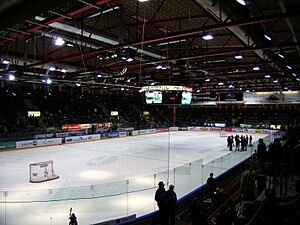
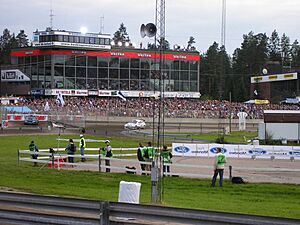

Jyväskylä is often called the "capital of Finnish sport." The University of Jyväskylä is the only university in Northern Europe with a sports faculty. This has helped create a strong sports culture in the city.
The city is famous for hosting the Secto Rally Finland. This car rally is the biggest annual public event in the Nordic countries. It has been held since 1951.
Many sports venues are located in Hippos, just two kilometers from the city center. These include the Synergia-areena for ice hockey and the Hippos Finnish baseball stadium. The Matti Nykänen ski jumping hill is also nearby. In winter, you can even ice skate on Lake Jyväsjärvi!
The inventor of Finland's national sport, pesäpallo (Finnish baseball), Lauri "Tahko" Pihkala, lived and studied in Jyväskylä. The first pesäpallo match ever was played here in September 1920.
Popular Sports Teams
- JYP: A top-tier men's ice hockey team. They won the Finnish Championship in 2009 and 2012.
- JYP Naiset: A successful women's ice hockey team.
- JyPK: A women's football team playing in Finland's top league.
- Jyväskylän Seudun Palloseura (JPS): A bandy team that won the Finnish Championship in 2019.
- Jyväskylän Kiri: The most successful men's pesäpallo team in history.
- Happee: Plays in the top Finnish floorball leagues for both men and women. The men's team won the Finnish Championship in 2014.
City Views
Jyväskylä was planned in 1833 with a grid-style city center. The city has grown very fast, leading to many changes in its buildings.
Today, Jyväskylä is known for its modern architecture. It has more buildings designed by the famous functionalist architect Alvar Aalto than any other city in the world. The main buildings of the University of Jyväskylä are considered some of Aalto's best works. Another architect, Arto Sipinen, who was Aalto's student, designed many new university buildings from the 1970s onwards.
The areas outside the city center mostly have student apartments and single-family houses. Some of Aalto's important buildings, like the Säynätsalo Town Hall, are located a bit further out in Säynätsalo. The western parts of Jyväskylä are mostly countryside with hilly forests and lakes.
Getting Around Jyväskylä
Jyväskylä is a central hub for roads and railways in Finland.
Train Travel
The Jyväskylä railway station has direct trains to major Finnish cities like Helsinki, Tampere, and Turku. The station was updated in 2002.
Air Travel
Jyväskylä Airport is about 20 kilometers north of the city in Tikkakoski. It has regular flights to Helsinki Airport. The airport is also used for military and charter flights.
Roads and Highways
Many main roads in Finland pass through Jyväskylä. Highway 4 (which is also E75) goes from south to north. Highway 9 (also E63) goes from southeast to northwest. Highway 23 also runs through the city.
Water Transport
The Jyväskylä harbour is a busy place for passenger ships on Lake Päijänne. In summer, you can take a boat to other cities like Lahti and Jämsä.
Public Buses
The city's public transportation uses buses, managed by the city under the Linkki brand.
Learning in Jyväskylä
Jyväskylä is famous for its education. With school children and students from various schools and universities, there are about 45,000 students in the city. This is why Jyväskylä is known as a "student city." Over 30% of the city's population are students!
Jyväskylä has been home to many "firsts" in Finnish education:
- The first junior secondary school in the world that taught in Finnish (Jyväskylä Lyceum, opened in 1858).
- The first Finnish-speaking teacher training college (1863).
- The first Finnish-speaking school for girls (1864).
- Finland's first Summer University (1912).
Because of this history, the city earned the nickname Athens of Finland. The teacher training college later became the University of Jyväskylä in 1966.
The University of Jyväskylä is very popular in Finland. Almost 16,000 students study there for different degrees. It's the only university in Finland that offers university-level education in sports. The university also offers degrees in Cyber Security, working closely with the Finnish Defence Forces. In 2013, Jyväskylä was recognized as a "Cyber Security City."
JAMK University of Applied Sciences has 8,000 students. It has different schools for business, health, technology, and teacher education. HUMAK University of Applied Sciences also teaches cultural management in Jyväskylä.
Famous People from Jyväskylä
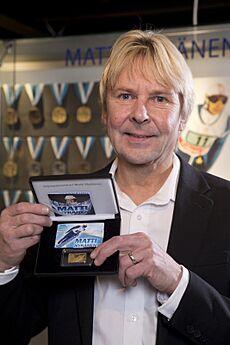
Many talented people come from Jyväskylä, including artists, musicians, and sports stars.
Artists and Performers
- Gettomasa, a rap artist
- Ismo Leikola, a stand-up comedian
- Wivi Lönn, an architect
- Sofi Oksanen, a well-known writer
- Timo Parvela, who writes books for young people
Music Groups
- Steve 'n' Seagulls, a country band
- Swallow the Sun, a metal band
Politicians and Leaders
- Matti Vanhanen, a former Prime Minister of Finland
Sports Heroes
- Mikko Hirvonen, a rally driver
- Juha Kankkunen, a four-time World Rally Champion
- Lauri Markkanen, a basketball player
- Tommi Mäkinen, a four-time World Rally Champion
- Matti Nykänen, an Olympic gold medalist in ski jumping
- Lauri "Tahko" Pihkala, the inventor of Finnish baseball
- Kalle Rovanperä, a two-time World Rally Champion
Global Connections
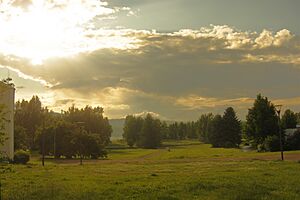
Jyväskylä is part of the Eurotowns network and has "twin city" relationships with many cities around the world. These connections help promote friendship and understanding between different cultures.
Twin Cities and Friendship Cities
Images for kids
See also
 In Spanish: Jyväskylä para niños
In Spanish: Jyväskylä para niños



